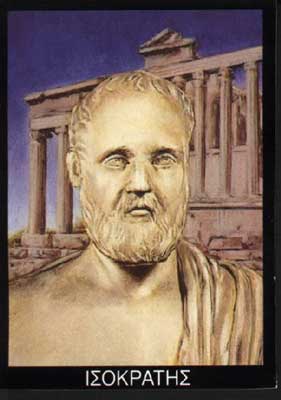.
καὶ τὸ τῶν Ἑλλήνων ὄνομα πεποίηκε μηκέτι τοῦ γένους ἀλλὰ τῆς διανοίας δοκεῖν εἶναι, καὶ μᾶλλον Ἕλληνας καλεῖσθαι τοὺς τῆς παιδεύσεως τῆς ἡμετέρας ἢ τοὺς τῆς κοινῆς φύσεως μετέχοντας (The name Greek is no longer a mark of a race, but of an outlook, and is accorded to those who share our culture rather than our blood)

Isocrates (c. 436-–338 BC) (Ισοκράτης), son of Theodorus Erchieus (producer of musical instruments from the Deme Ercheia), Greek rhetorician, was one of the ten Attic orators. In his time, he was probably the most influential rhetorician in Greece and made many contributions to rhetoric and education through his teaching and written works.
Greek rhetoric is commonly traced to Corax of Syracuse, who first formulated a set of rhetorical rules in the fifth century BC. His pupil, Tisias, was influential in the development of the rhetoric of the courtroom, and by some accounts was the teacher of Isocrates. Within two generations, rhetoric had become an important art, its growth driven by the social and political changes, such as democracy and the courts of law.
The demand for rhetorical training was so high that a number of philosophers and teachers set up their own schools to train orators. Among these were the Sophists, which included such teachers as Isocrates and Gorgias. These schools proved to be a lucrative enterprise, and later attracted less reputable characters.
Isocrates' professional career is said to have begun as a logographer, or a hired courtroom speech writer. Around 392 BC he set up his own school of rhetoric, and proved to be not only an influential teacher, but a shrewd businessman. His fees were unusually high, but he managed to attract more students than any other school. As a consequence, he amassed a considerable fortune.
Because of Plato's attacks on the Sophists, this school of rhetoric and philosophy came to be viewed as unethical and deceitful. Yet many of Plato's criticisms are hard to discern in the work of Isocrates. He saw the ideal orator as someone who must not only possess rhetorical gifts, but possess also a wide knowledge of philosophy, science, and the arts. The orator should also represent Greek ideals of freedom, self-control, and virtue. In this, he was an influence on Roman rhetoricians, such as Cicero and Quintilian, and on the idea of liberal education.
On the art of rhetoric, he was also an innovator. He promoted a clear and natural style that avoided artificiality, while providing rhythm and variation that commanded the attention of the listener. Like most rhetoricians, he saw rhetoric as a method of clarifying the truth, rather than one of obscuring it.
Of the 60 orations in his name available in Roman times, 21 were transmitted by ancient and medieval scribes. Another three orations were found in a single codex during a 1988 excavation at Kellis, a site in the Dakhleh Oasis of Egypt. We have nine letters in his name, but the authenticity of four have been questioned. He is said to have compiled a treatise, the Art of Rhetoric, but it has not survived. In addition to the orations, other works include his autobiographical Antidosis and educational texts, such as Against the Sophists.
Students and Friends: Hyperides, Isaeus and Lycurgus, Aeschines (Info) , Evagoras and Nicocles from Cyprus, Demosthenes, Ephorus, Theopompus, Timotheus...
Speeches: To Demonicus (Πρὸς Δημόνικον ), To Nicocles (Πρὸς Νικοκλέα ), Nicocles or the Cyprians (Νικοκλῆς ), Panegyricus (Πανηγυρικός ), To Philip (Φιλίππος ), Archidamus (Ἀρχίδαμος), Areopagiticus (Ἀρεοπαγιτικός ), On the Peace (Συμμαχικὸς ἢ Περὶ εἰρήνης ), Evagoras (Εὐαγόρας), Helen (Ἑλένης ἐγκώμιον ), Busiris (Βούσιρις ), Panathenaicus (Παναθηναϊκός ), Against the Sophists (Κατὰ τῶν σοφιστῶν ), Plataicus (Πλαταικός ), Antidosis (Περὶ τῆς Ἀντιδόσεως ), On the team of horses (Περὶ τοῦ ζεύγους ), Trapeziticus (Τραπεζιτικός ), Against Callimachus (Πρὸς Καλλίμαχον ), Aegineticus (Αἰγινητικός), Against Lochites (Πρὸς Λοχίτην ), Against Euthynus, (Πρὸς Εὐθύνουν )
Timeline
c. 403 BC work as a "Logograph"
c. 392/0 BC opens a school in Chios,
380 BC Panegyricus ( Πανηγυρικός ) assumed to be inspired by Gorgias' Ὀλυμπικός around 408 BC
c. 373 BC Plataicus (Πλαταικός )
357 BC On the Peace ( Συμμαχικὸς ἢ Περὶ εἰρήνης )
354 BC Areopagiticus , Antidosis
342-339 BC , Panathenaicus
On a pillar is a statue of Isocrates, whose memory is remarkable for three things: his diligence in continuing to teach to the end of his ninety-eight years, his self-restraint in keeping aloof from politics and from interfering with public affairs, and his love of liberty in dying a voluntary death, distressed at the news of the battle at Chaeronea. Pausanias
Links
Online English and Greek editions (http://www.perseus.tufts.edu/cgi-bin/ptext?doc=Perseus%3Atext%3A1999.01.0144)
http://www.lcc.gatech.edu/gallery/rhetoric/figures/isocrates.html
http://people.morehead-st.edu/fs/w.willis/isocrates.html
References
Bibliography
Bryant, Donald C., ed. Ancient Greek and Roman Rhetoricians: A Biographical Dictionary. Columbia, MO 1969.
Isocrates. Volumes I and II, translated by George Norlin. Volume III, translated by Larue van Hook. Loeb Classical Library, London, 1928, 1929, 1945.
| Ancient Greece
Science, Technology , Medicine , Warfare, , Biographies , Life , Cities/Places/Maps , Arts , Literature , Philosophy ,Olympics, Mythology , History , Images Medieval Greece / Byzantine Empire Science, Technology, Arts, , Warfare , Literature, Biographies, Icons, History Modern Greece Cities, Islands, Regions, Fauna/Flora ,Biographies , History , Warfare, Science/Technology, Literature, Music , Arts , Film/Actors , Sport , Fashion --- |
Retrieved from "http://en.wikipedia.org"
All text is available under the terms of the GNU Free Documentation License

